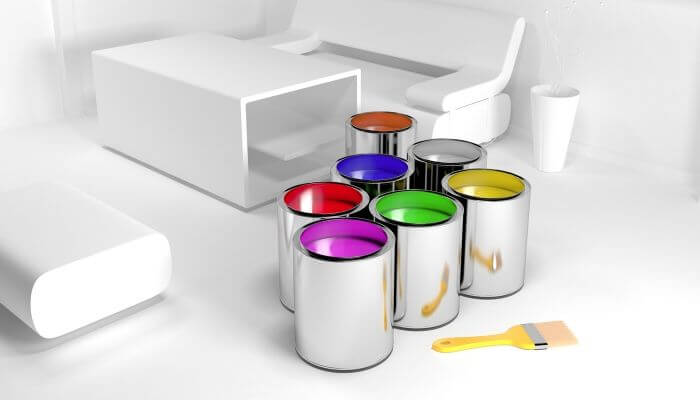Economical, easy to apply and capable of transforming any space in one or two passes, it is a work available to anyone with a little patience and planning. We go through the pros and cons so you don’t say you didn’t know what you were getting into.
IN FAVOR: SAVINGS
Contrary to what happens with other types of reforms, which require technical knowledge to achieve acceptable results, painting the walls of the house is relatively easy. Especially if we do it in a single color and, preferably, of course, that the light scatters and blurs the possible imperfections of the walls and in the application of the paint. Think that by doing it yourself you can save up to 70% of what the work done by a professional would entail. Although no one has quantified what percentage of stiffness you could save if you left it in the hands of an expert.
MANDATORY PLAN

Just because painting isn’t too complicated doesn’t mean we go for a pot of paint and a couple of brushes and get down to it in a little while before dinner. Professionals have these questions at hand, but we, as newbies, do not. In addition to carefully analyzing what color we want to use and if it is suitable for our project, it will be necessary to calculate how much paint we need, what type, what tools you need, how much time you will dedicate to it … Make a list of all this (including questions) before to go to a specialized establishment where they can advise you.
A WORK FOR YOU
Although if you hire a professional it is usually more advisable to paint the whole house, both for a cost issue and to minimize the inconvenience of the works at home, if the work is done by yourself it is better to focus on one room, so that we can start and finish the painting in a short period of time: a weekend, for example. Having to dodge paintbrushes and paint cans, plus off-site furniture, is not the best way to tackle Monday.
INVEST IN QUALITY
Plastic paint is the most suitable for ceilings and walls, since its water-based composition simplifies both its application and the cleaning of possible stains and splashes, as well as the utensils used. Since you are not going to spend on labor, choose it with a good hiding power, preferably monolayer and anti-drip since, although they may be somewhat more expensive than the first price, you will end up saving time and labor.
In general terms, a liter of plastic paint usually serves about 20 square meters, although each manufacturer specifies this information on the packaging. And, if you are not clear, use one of the practical online calculators that many of them have on their websites.
HASTE IS NOT A GOOD COMPANION

You have the color in your head, you dream of the perfect shade and, what is even better, you have located it in a sample card. Before arriving home with 20 liters of paint, get a sample –or better, two or three, in somewhat lighter and darker tones– and test them on the different walls to be painted to assess them once they are dry –the color rises– at different times of the day, with and without sun, with natural and artificial light …
Nobody wants to spend a Saturday painting to discover the next morning that the room seems smaller than the day before or the tone we were after was not exactly that.
BETTER THAN.
It is time to get enough paint and a little more, in case our calculations were not completely correct or to save it to correct possible scratches or stains. Colors made to measure with tinting machines are very useful in this regard, since they incorporate a reference with which they can reproduce the exact color in case of having to fix a defect. Make sure to store it in a safe place and avoid the temptation to ‘lighten’ or darken the color on your own at home, as it will be impossible to reproduce exactly and the patches will be visible.
APPROPRIATE TOOLS

Tools often make the difference between a professional job and a slop, so don’t skimp here either. Although we used to refer to it as paintbrush, for walls and ceilings, better a roller. There are many types although a medium-fiber multipurpose is perfect for almost most cases, except in the case of rough walls or with gotelé, in which longer hair proposals are recommended to fill in the gaps. A telescopic bar to reach the top of the walls will save you effort – and that nobody looks over your shoulder, if we are not very high …-. A brush for corners and difficult holes is also necessary.
UNDER COVER
It is about painting ceilings and walls, not the furniture or the floor, so if we do not want to spend more time cleaning than it has taken us to paint, it is convenient to protect them adequately something that painters take care of, in case of hired labor: you can’t have everything. The best thing is to group the furniture in the center of the room and protect it with plastic which adapts well to the contour – or old sheets. The floor is another matter: to avoid slipping risks and that the paint that does not dry in the plastic ends up adhering to our shoes – and with them, to other areas of the house – replace it with the cardboard rolls of those that use the painters: they are not expensive at all and facilitate the task of collection once finished. Finally, the paper tape will help us protect door and window frames,
IT IS BETTER PREVENT
A quick glance at the walls before getting down to work will reveal flaws that could be accentuated when applying the wet paint: chipping, cracks, deep scratches, dowel holes that are no longer useful … It prevents all the work from being tarnished by Those small imperfections of the substrate removing any loose residue with a spatula and applying repair putty. Let it dry, clean the walls with a damp cloth and, when they are dry again – and free of dirt that can make the paint not fix well – you can start painting.
THERETO
Start painting. Although it seems obvious, if you want to achieve good results, always paint from top to bottom (and first the ceilings), to avoid dripping. Professional painters advise cutting pieces about 60 cm down and to the side and using the roller not too heavily loaded, to avoid accumulations of paint that could drip. Don’t forget to ventilate the room well, allow a minimum of 8 hours to pass between layers – if more than one is necessary – and cover your head and eyes to avoid splashing. When to hire a painter
Unless you are already a true expert in the field, there are painting jobs that should be left in the hands of a professional if you want the result to be optimal:
- Eliminate gotelé. Although there are pastes for it, they require a certain hand to apply them and successive sanding and polishing that will mark the final effect.
- Effects with paint. Stripes, color combinations and paints with satin or special finishes will save us a lot of frustration if we let an experienced painter do them.
- Specific treatments for walls with humidity, humid rooms or even thermal ones. Applied paints tend to be more technical, often synthetic based, and more difficult to handle.
- Very high walls, which require specific equipment, or even outdoors, which involve greater risks.
- Lacquered doors and windows. Although it is possible to do it at home, the work in the workshop, with special tools, will leave them like new.



Leave a Reply